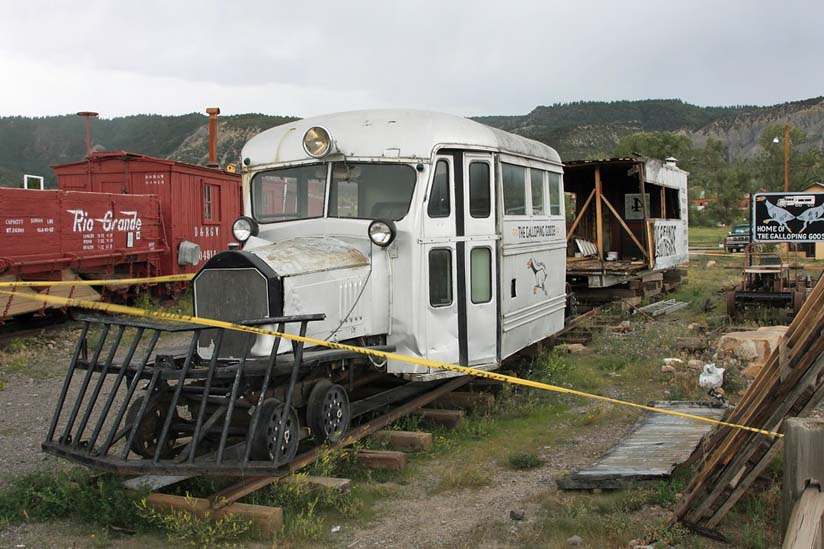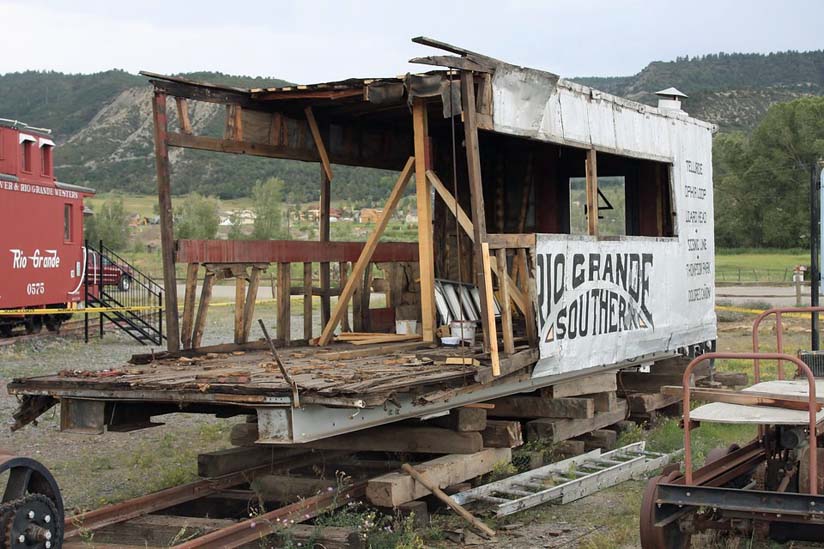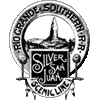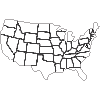
Ridgway Colorado USA - Another "Galloping Goose" has recently returned to Ridgway.
The famed "Motors" (also known as Galloping Geese late in their careers) of the Rio Grande Southern Railroad (RGS) were conceived in 1931 by RGS receiver Victor Miller as a money-saving substitute for steam powered passenger trains.
RGS mechanic Jack Odenbaugh created the motors in Ridgway.
Eventually seven motors were built which helped the railroad survive into the early 1950s.
Six of the original seven still exist and all but motor No. 4 have been restored to operating condition.
Motor No. 4 has been sitting next to the Telluride Courthouse for more than 50 years.
The heavy snowfall of last winter caused several of the roof ribs to break and it is unlikely it would have survived another winter.
Galloping Goose, with capitals, was the official RGS public name for the RGS Motors only after their conversion to the tourist version in the early 1950s, and this name only applies to Motors 3, 4, 5, and 7.
Before that time the RGS always referred to them as Motors in any official publications.
Without capitals, "galloping goose" is a generic name applied to a wide variety of automotive/rail hybrids.
 There was also a Galloping Goose
There was also a Galloping Goose that ran on southern Vancouver Island in British Columbia.
that ran on southern Vancouver Island in British Columbia.
The first public application of the words "Galloping Geese" to the RGS Motors was in a 1942 article by the Rocky Mountain Railroad Club in the Denver Post.
The original Motor 1 was scrapped in order to build Motor 2, but local railroad expert Karl Schaeffer, who also is now president of the Ridgway Railroad Museum, built a nearly exact operating replica of Motor 1, which is now located at the local museum.
Motor 2 was never converted for tourist use and hence should not be referred to as a Galloping Goose.
Finally, Motor 6 was only used for railroad maintenance work and also should not be referred to as a Galloping Goose.
In late May the Ridgway Railroad Museum signed a formal agreement with the Telluride Volunteer Fire Department (TVFD) to bring Galloping Goose No. 4 to Ridgway for a comprehensive non-operating restoration and an evaluation of a possible future operational restoration.
The TVFD deserves a big thank you for keeping No. 4 in condition such that it is still possible to do this restoration after 55 years.
When the restoration is finished in about three years, the plan is for it to return to Telluride.
The Ridgway Railroad Museum will do the work and the TVFD will pay for the materials.
On 29 May 2008, the Telluride Goose made its first trip over Dallas Divide since 1953.
Jamie Schuler, TVFD fire chief, and his crew had several things done prior to the move.
A section of the fence at the San Miguel County Courthouse was removed, and the street blocked off so that the lowboy tractor-trailer could back into place.
The Ridgway Railroad Museum crew arrived at 09:00 and the semi truck arrived from Cortez at 09:45.
This is the same company that moves Galloping Goose No. 5 from Dolores when it makes public appearances on the Durango-Silverton and the Cumbres & Toltec Railroads.
With the help of the Telluride fireman, blocking was put in place and rail was spliced between the panel track on the lowboy and the rail that Motor 4 was resting on next to the Courthouse.
Larry Spencer, president of the Galloping Goose Historical Society of Dolores, climbed into the Wayne Bus Body cab and served as the motorman for No. 4 as it began the 55 foot journey onto the trailer.
The four chains that secured Motor 4 to the rail had been cut earlier, and the slow process of moving the Motor began.
Because the Motor was on rail that sloped toward the street, a winch Schaeffer's truck slowly let out cable from behind the Motor, while the winch on the trailer helped ease the Motor onto the lowboy from the front.
A hearty cheer from the Telluride "sidewalk superintendents" greeted the successful completion of this step.
By 11:05 the Motor was chained down and ready for transport.
A quick stop at the top of Dallas Divide at 11:50 provided an opportunity for photos.
Arriving at the Museum at 12:10, the Motor was in place on its track by 12:45.
Work began on Motor No. 4 last week during the museum's annual workweek.
This summer and fall we will be working on the goose on Tuesdays, Thursdays, and Saturdays.
If interested in working on this project, call Schaeffer at 626-4373.
Author unknown.

provisions in Section 29 of the Canadian
Copyright Modernization Act.










